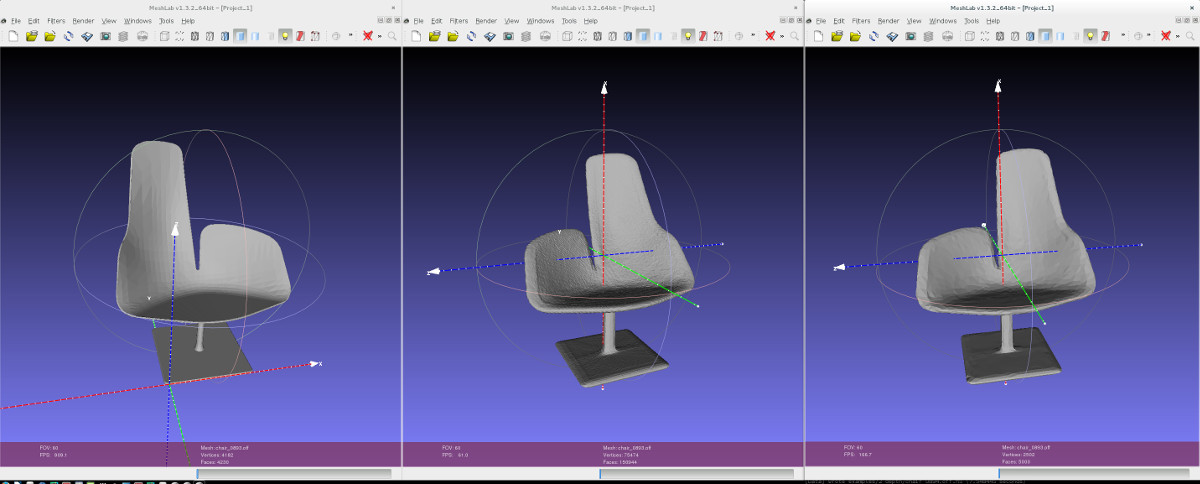This repository contains a simply Python pipeline for obtaining watertight
and simplified meshes from arbitrary triangular meshes, given in .off format.
The approach is largely based on adapted versions of Gernot Riegler's
pyrender and pyfusion;
it also uses PyMCubes.
If you use any of this code, please make sure to cite the following work:
@article{Stutz2018ARXIV,
author = {David Stutz and Andreas Geiger},
title = {Learning 3D Shape Completion under Weak Supervision},
journal = {CoRR},
volume = {abs/1805.07290},
year = {2018},
url = {http://arxiv.org/abs/1805.07290},
}
See the GitHub repositories above for additional citations. Also check the corresponding project page.
The pipeline consists of three steps:
- Scaling using
1_scale.py, which scales the meshes into[-0.5,0.5]^3with optional padding. - Rendering and fusion using
2_fusion.pywhich in a first step renders views of each mesh, and uses these to peform TSDF fusion. - Simplification using MeshLab.
The result is illustrated below; note that the shape gets slightly thicker and the axes change (due to marching cubes).
The pipeline is mostly self-contained, given a working installation of Python. Additionally, it requires MeshLab for simplification.
The used pyfusion library requires
CMake and Cython; optionally it uses CUDA or OpenMP for efficiency.
pyrender requires Cython, as well.
Additionally, it requires OpenGL, GLUT and GLEW, see librender/setup.py
for details. PyMCubes requires Cython.
All three libraries are included in this repository.
For building follow (illustrated for the GPU version):
# build pyfusion
# use libfusioncpu alternatively!
cd libfusiongpu
mkdir build
cd build
cmake ..
make
cd ..
python setup.py build_ext --inplace
cd ..
# build pyrender
cd librender
python setup.py build_ext --inplace
cd ..
# build PyMCubes
cd libmcubes
python setup.py build_ext --inplace
Usage is illustrated on the shipped examples in examples/0_in taken
from ModelNet.
First, scale the models using:
python 1_scale.py --in_dir=examples/0_in/ --out_dir=examples/1_scaled/
Now the models can be rendered, per default, 100 views (uniformly sampled on a sphere) will be used:
2_fusion.py --mode=render --in_dir=examples/1_scaled/ --depth_dir=examples/2_depth/ --out_dir=examples/2_watertight/
The details of rendering can be controlled using the following options:
--n_views N_VIEWS Number of views per model.
--image_height IMAGE_HEIGHT
Depth image height.
--image_width IMAGE_WIDTH
Depth image width.
--focal_length_x FOCAL_LENGTH_X
Focal length in x direction.
--focal_length_y FOCAL_LENGTH_Y
Focal length in y direction.
--principal_point_x PRINCIPAL_POINT_X
Principal point location in x direction.
--principal_point_y PRINCIPAL_POINT_Y
Principal point location in y direction.
--depth_offset_factor DEPTH_OFFSET_FACTOR
The depth maps are offsetted using
depth_offset_factor*voxel_size.
--resolution RESOLUTION
Resolution for fusion.
--truncation_factor TRUNCATION_FACTOR
Truncation for fusion is derived as
truncation_factor*voxel_size.
During rendering, a small offset is added to the depth maps. This is particular important for meshes with thin details, as for example the provided chairs. Essentially, this thickens the structures. In the code, the offset is computed as
voxel_size = 1/resolution
offset = depth_offset_factor*voxel_size
Now, fusion can be run using
python 2_fusion.py --mode=fuse --in_dir=examples/1_scaled/ --depth_dir=examples/2_depth/ --out_dir=examples/2_watertight/
For fusion, the resolution and the truncation factor are most importance.
In practice, the truncation factor may be in the range of [0, ..., 15];
then, the truncation threshold is computed as
voxel_size = 1/resolution
truncation = truncatioN_factor*voxel_size
Note that rendering and fusion is splitted as rendering might not work on all machines, especially remotely (e.g. through ssh) on machines without monitor.
Finally, simplification is performed using meshlabserver; make sure to have
it installed and run
python 3_1_simplify.py --in_dir=examples/2_watertight/ --out_dir=examples/3_out/
The result of all steps is illustrated in the screenshot above.
See pyrender, pyfusion; and PyMCubes. The remaining code is licensed as follows:
Copyright (c) 2018, David Stutz All rights reserved.
Redistribution and use in source and binary forms, with or without modification, are permitted provided that the following conditions are met:
- Redistributions of source code must retain the above copyright notice, this list of conditions and the following disclaimer.
- Redistributions in binary form must reproduce the above copyright notice, this list of conditions and the following disclaimer in the documentation and/or other materials provided with the distribution.
- Neither the name of the copyright holder nor the names of its contributors may be used to endorse or promote products derived from this software without specific prior written permission.
THIS SOFTWARE IS PROVIDED BY THE COPYRIGHT HOLDERS AND CONTRIBUTORS "AS IS" AND ANY EXPRESS OR IMPLIED WARRANTIES, INCLUDING, BUT NOT LIMITED TO, THE IMPLIED WARRANTIES OF MERCHANTABILITY AND FITNESS FOR A PARTICULAR PURPOSE ARE DISCLAIMED. IN NO EVENT SHALL THE COPYRIGHT HOLDER OR CONTRIBUTORS BE LIABLE FOR ANY DIRECT, INDIRECT, INCIDENTAL, SPECIAL, EXEMPLARY, OR CONSEQUENTIAL DAMAGES (INCLUDING, BUT NOT LIMITED TO, PROCUREMENT OF SUBSTITUTE GOODS OR SERVICES; LOSS OF USE, DATA, OR PROFITS; OR BUSINESS INTERRUPTION) HOWEVER CAUSED AND ON ANY THEORY OF LIABILITY, WHETHER IN CONTRACT, STRICT LIABILITY, OR TORT (INCLUDING NEGLIGENCE OR OTHERWISE) ARISING IN ANY WAY OUT OF THE USE OF THIS SOFTWARE, EVEN IF ADVISED OF THE POSSIBILITY OF SUCH DAMAGE.
